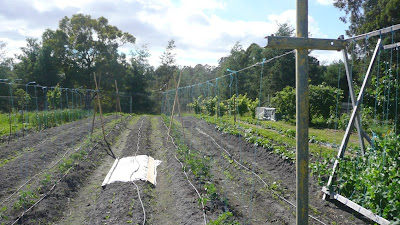When we started vegie gardening it was on a small scale. We made raised beds, usually with edges made of wood or bricks we planted haphazardly and we mulched to keep weeds at bay. As we've expanded, this has become impractical. There is just too much bed area to mulch and when weeds do come up, as they inevitably do unless the mulch is very thick, there's too much area to weed.
In market gardens, things are grown in neat rows in a large tilled area that may or may not have slightly raised beds. With neat rows and no edging, it's easy to walk along with a sharp hoe and weed a huge are in a short time.
So, that's how we grow our annual crops now. We plant in rows of slightly raised beds roughly 70cm wide with 40cm paths in between

With these three hoes, the Ho-mi (left), Dutch hoe (middle) and nameless hook-shaped hoe (right) we keep the beds in shape and without (too many) weeds.

The Ho-mi is not sharpened and is used for hilling and trenching, for potatoes, for example, or keeping the edges of the beds well shaped. The dutch and hook hoe are sharpened very sharply, to cut rather than drag weeds. The dutch hoe is pushed back and forth along straight, open runs of soil. The blade runs just on the surface and slices the weeds off.

The hook hoe is used to manouevre around plants and also slices off weeds. this is our most used hoe. It's a really quick and satisfying way to weed. A whole 25 metre long bed can be done in about 10 minutes.


























































